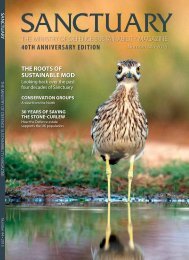SUSTAINABILITY
UBUt5
UBUt5
You also want an ePaper? Increase the reach of your titles
YUMPU automatically turns print PDFs into web optimized ePapers that Google loves.
AROUND THE REGIONS<br />
Wiltshire<br />
MOD Corsham<br />
20<br />
Overgrown pond © Nicky Wookey<br />
A purpose built pond for great crested<br />
newts (GCN) Triturus cristatus was<br />
surveyed in 2007 and confirmed the<br />
presence of the species as well as<br />
palmate Lissotriton helveticus and<br />
smooth newt Lissotriton vulgaris.<br />
Unfortunately a repeat survey in 2013<br />
only found palmate and smooth newts.<br />
The reason for their absence is<br />
unknown, although a combination of<br />
predation and a reduction in habitat<br />
quality may be factors. This prompted<br />
conservation works to the pond which<br />
included cutting back banks of bramble<br />
and trimming trees to reduce shading.<br />
As pond management works were<br />
proposed for late 2014, a follow up<br />
survey was carried out in April 2014. This<br />
confirmed a maximum count of 14 GCN,<br />
along with smooth and palmate newts.<br />
out the pond management work<br />
providing the method statement was<br />
followed to the letter. The aim was to<br />
undertake habitat improvement in<br />
January 2015.<br />
The majority of the pond had been<br />
swamped by reed, with over-hanging<br />
willow on its northern and eastern side.<br />
Leaf litter, branches and silt equated to<br />
approximately 30cm in depth.<br />
To improve the condition of the<br />
pond in line with the GCN<br />
Conser vation Handbook the<br />
following task s were identified.<br />
• Partially pulling of emergent<br />
vegetation<br />
• Cutting back over hanging trees<br />
• Partial-desilting and clearance<br />
of leaf-fall<br />
Where possible the works proposed<br />
would aim to provide the following<br />
characteristics:<br />
• Surface area between 100<br />
and 300m 2<br />
• Depth may vary; both deep<br />
(up to 4m) and shallows<br />
• Substantial cover of submerged<br />
and marginal vegetation<br />
• Open areas to facilitate courtship<br />
• Absence of shading on the<br />
south side<br />
• Absence of fish<br />
• Absence or low density of<br />
water fowl<br />
Partial removal of marginal and<br />
emergent vegetation was carried out<br />
by hand and a ‘fringe’ of vegetation<br />
was left around at least a half of the<br />
pond edge.<br />
Trees and scrub on the northern side<br />
of the pond were retained though<br />
shading vegetation on the southern<br />
sides was removed. Log piles were left<br />
and scrub vegetation was cut-back just<br />
above ground level. Care was taken<br />
not to remove vegetation in areas that<br />
may be used as a hibernacula.<br />
Silt and debris was removed by hand<br />
to increase the general depth of the<br />
pond and provide open areas.<br />
Nicky Wookey<br />
Compliance Advisor<br />
Interserve Support Services<br />
As GCNs were recorded, under the<br />
Wildlife and Countryside Act 1981 (as<br />
amended), no works should be<br />
undertaken in and around the pond<br />
without a Conservation Licence from<br />
Natural England (NE). Af ter discussions<br />
with NE, it was confirmed that a licence<br />
would not be required as the method<br />
statement was updated. Interserve<br />
personnel were given the task to carry<br />
Conservation works to the pond © Nicky Wookey<br />
Sanctuary 44 • 2015 93



